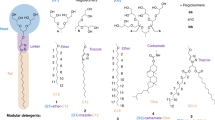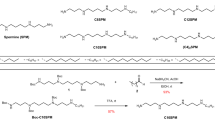Abstract
The biological membrane is a complicated matrix wherein different lipid environments are thought to exist. The more ordered or raft environment has been perceived biochemically accessible via its relative resistance to detergent. This paper outlines the protocols developed in our laboratory for the analysis of such detergent-resistant membranes (DRMs). We stress the fact that DRMs are artifactual in nature and should not be equivocated to lipid rafts, their usefulness being limited to assigning raft-association potential most convincingly when changes in DRM composition are induced by biochemically/physiologically relevant events. These protocols are completed in 1–2 d.
This is a preview of subscription content, access via your institution
Access options
Subscribe to this journal
Receive 12 print issues and online access
$259.00 per year
only $21.58 per issue
Buy this article
- Purchase on Springer Link
- Instant access to full article PDF
Prices may be subject to local taxes which are calculated during checkout


Similar content being viewed by others
References
Rajendran, L. & Simons, K. Lipid rafts and membrane dynamics. J. Cell. Sci. 118, 1099–1102 (2005).
Pike, L.J. Rafts defined: a report on the Keystone Symposium on Lipid Rafts and Cell Function. J. Lipid Res. 47, 1597–1598 (2006).
Hancock, J.F. Lipid rafts: contentious only from simplistic standpoints. Nat. Rev. Mol. Cell Biol. 7, 456–462 (2006).
Lucero, H.A. & Robbins, P.W. Lipid rafts-protein association and the regulation of protein activity. Arch. Biochem. Biophys. 426, 208–224 (2004).
Meder, D. & Simons, K. Lipid rafts, caveolae, and membrane traffic. In Lipid Rafts and Caveolae. From Membrane Biophysics to Cell Biology (ed. Fielding, C.J.) 1.1–1.23 (Wiley-VGH Verlag GmbH & Co., Wienheim, Germany, 2006).
Schuck, S. & Simons, K. Polarized sorting in epithelial cells: raft clustering and the biogenesis of the apical membrane. J. Cell Sci. 117, 5955–5964 (2004).
Simons, K. & Vaz, W.L. Model systems, lipid rafts, and cell membranes. Annu. Rev. Biophys. Biomol. Struct. 33, 269–295 (2004).
Simons, K. & Ikonen, E. Functional rafts in cell membranes. Nature 387, 569–572 (1997).
Meder, D., Moreno, M.J., Verkade, P., Vaz, W.L. & Simons, K. Phase coexistence and connectivity in the apical membrane of polarized epithelial cells. Proc. Natl. Acad. Sci. USA 103, 329–334 (2006).
Baumgart, T. et al. Large-scale fluid/fluid phase separation of proteins and lipids in giant plasma membrane vesicles. Proc. Natl. Acad. Sci. USA 104, 3165–3170 (2007).
Brown, D.A. & Rose, K.J. Sorting of GPI-anchored proteins to glycolipid enriched membrane subdomains during transport to the apical cell surface. Cell 68, 533–544 (1992).
Schroeder, R., London, E. & Brown, D. Interactions between saturated acyl chains confer detergent resistance on lipids and glycosylphosphatidylinositol (GPI)-anchored proteins: GPI-anchored proteins in liposomes and cells show similar behavior. Proc. Natl. Acad. Sci. USA 91, 12130–12134 (1994).
Kurzchalia, T.V., Hartmann, E. & Dupree, P. Guilty by insolubility—does a protein's detergent insolubility reflect caveolar location? Trends Cell Biol 5, 187–189 (1995).
Lichtenberg, D., Goñi, F.M. & Heerklotz, H. Detergent-resistant membranes should not be identified with membrane rafts. Trends Biochem. Sci. 30, 430–436 (2005).
Brown, D.A. Lipid rafts, detergent-resistant membranes, and raft targeting signals. Physiology 21, 430–439 (2006).
Helenius, A. & Simons, K. Solubilization of membranes by detergents. Biochim. Biophys. Acta 415, 29–79 (1975).
Ahmed, S.N., Brown, D.A. & London, E. On the origin of sphingolipid/cholesterol-rich detergent-insoluble cell membranes: physiological concentrations of cholesterol and sphingolipid induce formation of a detergent-insoluble, liquid-ordered phase in model membranes. Biochemistry 36, 10944–10953 (1997).
Sáez-Cirión, A. et al. Equilibrium and kinetic studies of the solubilization of phospholipid-cholesterol bilayers by C12E8. The influence of the lipid phase structure. Langmuir 16, 1960–1968 (2000).
Xu, X. et al. Effect of the structure of natural sterols and sphingolipids on the formation of ordered sphingolipid/sterol domains (rafts). Comparison of cholesterol to plant, fungal, and disease-associated sterols and comparison of sphingomyelin, cerebrosides, and ceramide. J. Biol. Chem. 276, 33540–33546 (2001).
Dietrich, C. et al. Lipid rafts reconstituted in model membranes. Biophys. J. 80, 1417–1428 (2001).
Heerklotz, H. Triton promotes domain formation in lipid raft mixtures. Biophys. J. 83, 2693–2701 (2002).
Heerklotz, H., Szadkowska, H., Anderson, T. & Seelig, J. The sensitivity of lipid domains to small perturbations demonstrated by the effect of Triton. J. Mol. Biol. 329, 793–799 (2003).
Montixi, C. et al. Engagement of T cell receptor triggers its recruitment to low-density detergent-insoluble membrane domains. EMBO J. 17, 5334–5348 (1998).
Röper, K., Corbeil, D. & Huttner, WB. Retention of prominin in microvilli reveals distinct cholesterol-based lipid micro-domains in the apical plasma membrane. Nat. Cell. Biol. 2, 582–592 (2000).
Radeva, G. & Sharom, F.J. Isolation and characterization of lipid rafts with different properties from RBL-2H3 (rat basophilic leukaemia) cells. Biochem. J. 380, 219–230 (2004).
Alfalah, M. et al. A novel type of detergent-resistant membranes may contribute to an early protein sorting event in epithelial cells. J. Biol. Chem. 280, 42636–42643 (2005).
Schuck, S., Honsho, M., Ekroos, K., Shevchenko, A. & Simons, K. Resistance of cell membranes to different detergents. Proc. Natl. Acad. Sci. USA 100, 5795–5800 (2003).
Arni, S., Keilbaugh, S.A., Ostermeyer, A.G. & Brown, D.A. Association of GAP-43 with detergent-resistant membranes requires two palmitoylated cysteine residues. J. Biol. Chem. 273, 28478–28485 (1998).
Schuck, S., Honsho, M. & Simons, K. Detergent-resistant membranes and the use of cholesterol depletion. In Cell Biology: A Laboratory Handbook Vol. 2 (ed. Celis, J.E.) 1.5–1.9 (Elsevier Science, USA, 2006).
Ostermeyer, A.G., Beckrich, B.T., Ivarson, K.A., Grove, K.E. & Brown, D.A. Glycosphingolipids are not essential for formation of detergent-resistant membrane rafts in melanoma cells. Methyl-beta-cyclodextrin does not affect cell surface transport of a GPI-anchored protein. J. Biol. Chem. 274, 34459–34466 (1999).
Shvartsman, D.E., Kotler, M., Tall, R.D., Roth, M.G. & Henis, Y.I. Differently anchored influenza hemagglutinin mutants display distinct interaction dynamics with mutual rafts. J. Cell Biol. 163, 879–888 (2003).
Field, K.A., Holowka, D. & Baird, B. Fc epsilon RI-mediated recruitment of p53/56lyn to detergent-resistant membrane domains accompanies cellular signaling. Proc. Natl. Acad. Sci. USA 92, 9201–9205 (1995).
Stauffer, T.P. & Meyer, T. Compartmentalized IgE receptor-mediated signal transduction in living cells. J. Cell Biol. 139, 1447–1454 (1997).
Holowka, D., Sheets, E.D. & Baird, B. Interactions between FcεRI and lipid raft components are regulated by the actin cytoskeleton. J. Cell Sci. 113, 1009–1019 (2000).
Simons, K. & Toomre, D. Lipid rafts and signal transduction. Nat. Rev. Mol. Cell Biol. 1, 31–39 (2000).
Simons, K. & Ehehalt, R. Cholesterol, lipid rafts, and disease. J. Clin. Invest. 110, 597–603 (2002).
Korzeniowski, M., Kwiatkowska, K. & Sobota, A. Insights into the association of FcγRII and TCR with detergent-resistant membrane domains: isolation of the domains in detergent-free density gradients facilitates membrane fragment reconstitution. Biochemistry 42, 5358–5367 (2003).
Louvard, D. Apical membrane aminopeptidase appears at site of cell-cell contact in cultured kidney epithelial cells. Proc. Natl. Acad. Sci. USA 77, 4132–4136 (1980).
Holloway, P.W. A simple procedure for removal of Triton X-100 from protein samples. Anal. Biochem. 53, 304–308 (1973).
Fasman, D.G. (ed.) Practical Handbook of Biochemistry and Molecular Biology (CRC Press, Boston, Massachusetts, 1992).
Acknowledgements
We thank S. Schuck (University of California, San Francisco) for his helpful review of the manuscript. D.L. was the recipient of an international NSERC PGS scholarship. Work was supported by DFG SFB TR13 and DFG 1175 grants.
Author information
Authors and Affiliations
Corresponding author
Ethics declarations
Competing interests
The authors declare no competing financial interests.
Rights and permissions
About this article
Cite this article
Lingwood, D., Simons, K. Detergent resistance as a tool in membrane research. Nat Protoc 2, 2159–2165 (2007). https://doi.org/10.1038/nprot.2007.294
Published:
Issue Date:
DOI: https://doi.org/10.1038/nprot.2007.294
This article is cited by
-
Emerging roles of prominin-1 (CD133) in the dynamics of plasma membrane architecture and cell signaling pathways in health and disease
Cellular & Molecular Biology Letters (2024)
-
MALL, a membrane-tetra-spanning proteolipid overexpressed in cancer, is present in membraneless nuclear biomolecular condensates
Cellular and Molecular Life Sciences (2022)
-
CLIC4 regulates late endosomal trafficking and matrix degradation activity of MMP14 at focal adhesions in RPE cells
Scientific Reports (2019)
-
The lipid raft-dwelling protein US9 can be manipulated to target APP compartmentalization, APP processing, and neurodegenerative disease pathogenesis
Scientific Reports (2017)
Comments
By submitting a comment you agree to abide by our Terms and Community Guidelines. If you find something abusive or that does not comply with our terms or guidelines please flag it as inappropriate.



